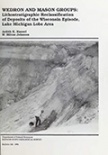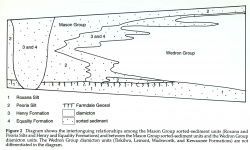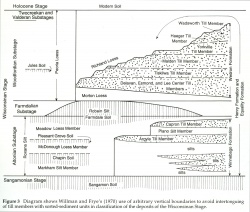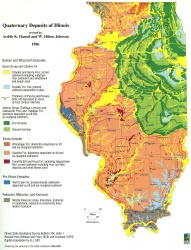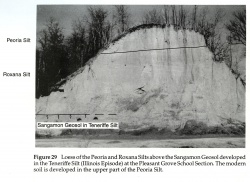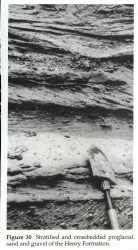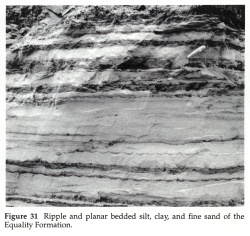Historical:Mason Group
Lithostratigraphy: Mason Group
Chronostratigraphy: Cenozoic Erathem >>Quaternary System >>Pleistocene Series
Authors
Ardith K. Hansel and W. Hilton Johnson
Name
Original description
This report.
Derivation
Mason County, central Illinois.
History/background
The Mason Group is established to classify four formations that contain fine to coarse grained, sorted sediment, occur in association with each other, and occur beneath, interfingered with, or above the diamicton formations of the Wedron Group (fig. 2). Because they primarily represent proglacial sedimentary environments that migrated with fluctuations of the ice margin during the Wisconsin Episode, these formations are in facies relationship with each other and the diamicton units of the Wedron Group.
|
With the exception of the Roxana Silt and the former Morton Loess, these sorted-sediment formations were formally recognized as lithostratigraphic units in the Willman and Frye (1970) classification only where they occur at or near the surface beyond the boundary of, or above units of the Wedron Group. Willman and Frye chose to classify tongues of sorted-sediment units that interfinger with diamicton units of the Wedron Group as facies of the diamicton units. They used arbitrary vertical boundaries to prevent the repetition of a unit in the same sequence (fig. 3). Although such classification of lithic facies results in a unique stratigraphic position for each unit, it tends to deemphasize the importance of buried sorted-sediment facies. Because recognition of lithic changes and correlation of sorted-sediment facies is critical in trying to understand relationships among glacial sedimentary lithofacies and in trying to predict their distribution, we established a classification framework that more clearly depicts relationships among lithic units even though it results in intertonguing of formal lithostratigraphic units.
Type section
None designated. Mason County is used as the type locality; good for the relationships among several formations (Roxana Silt, Peoria Silt, and Henry Formation) of the group.
Reference section
Wedron Section; good for the intertonguing relationships of the Peoria Silt and the Equality and Henry Formations of the Mason Group with the diamicton units of the Tiskilwa and Lemont Formations of the Wedron Group. Farm Creek Section; good for the Roxana Silt and the intertonguing relationships of the Peoria Silt and the Henry Formation of the Mason Group with the Tiskilwa Formation of the Wedron Group. Charleston Section; good for the intertonguing relationships of the Henry and Equality Formations of the Mason Group with the Tiskilwa Formation of the Wedron Group.
Stratigraphic relationships
The Mason Group comprises four sorted-sediment formations that represent distinct lithofacies differentiated on the basis of grain size and bedding characteristics. Only the basal formation, the Roxana Silt, does not interfinger with the diamicton formations of the Wedron Group; locally, it interfingers with the Henry and Equality Formations, however.
Generally, the Mason Group is readily distinguishable from the diamicton units of the Wedron Group. Tongues and lenses of the Mason Group can be differentiated from lenses of sorted sediment within the Wedron Group because the Mason Group tongues and lenses are more laterally continuous and occur at specific stratigraphic positions. Where the Mason Group overlies other sorted-sediment formations or sorted sediment within the Glasford or Winnebago Formations or older units, its relationships to key pedostratigraphic units (e. g., the Sangamon Geosol) or changes in lithology are helpful in differentiating it from other units.
Extent and thickness
The Mason Group is an extensive unit that blankets most of Illinois, and it ranges in thickness from less than 1 meter (3.3 ft) to about 30 meters (98 ft). It is present over much of the Lake Michigan Lobe area, including beneath Lake Michigan (Lineback et al. 1970). Beyond the Lake Michigan Lobe area, the Mason Group is thickest along the Illinois, Mississippi, Rock, Wabash, and Ohio River valleys (plate 1; Wanless 1957, Willman and Frye 1970, Frye et al. 1972, Willman 1973). The Mason Group formations are not known to occur in any one succession, but the occurrence of two or three formations in sequence or in facies relationship at one site is not uncommon.
Lithology
The Mason Group consists of sorted-sediment units that occur above the Sangamon Geosol and are differentiated predominantly on the basis of grain size and bedding characteristics. Four units of formation rank are recognized: (1) a basal unit, the Roxana Silt, generally lacks bedding structures, has a red brown cast, and appears massive in exposures (fig. 29); (2) the Peoria Silt, a yellow brown to gray silt that generally lacks bedding structures and appears massive in exposures (fig. 29); (3) the Henry Formation, predominantly bedded sand and gravel (fig. 30); and (4) the Equality Formation, predominantly silt and clay that generally shows some evidence of bedding (fig. 31). Some of these units, most commonly the Henry and Equality Formations and the Peoria Silt, intertongue with the diamicton formations of the Wedron Group.
Contacts
Lower boundary: the contact with diamicton tongues of the Wedron Group, or with the Sangamon Geosol, the Loveland Silt, the Glasford, Winnebago or Pearl Formations, or older units. Upper boundary: the contact with diamicton tongues of the Wedron Group or postglacial units.
Age and correlation
The bulk of the Mason Group was deposited during the Wisconsin Episode between about 70,000 and 11,000 radiocarbon years ago, but parts of it (e. g., lake Michigan Member, Equality Formation) were deposited during the postglacial Hudson Episode (appendix B). The Mason Group correlates in part with the Martinsville and Atherton Formations of Indiana (Wayne 1963) and unnamed units in Wisconsin, Iowa, Missouri, and Michigan.
Environments of deposition
The Mason Group is interpreted to be predominantly proglacial sediment of the Wisconsin Episode, although some postglacial sediment of the Hudson Episode is included. It consists of loess, eolian sand, outwash, and lacustrine sediment. This sediment, together with the intertonguing diamicton units of the Wedron Group, represents multiple glacigenic sequences that record the events of the last glaciation.
Remarks
New unit. Includes the Roxana Silt, Peoria Silt, Henry Formation, and Equality Formation, all of which are revised from Willman and Frye (1970).
References
FRYE, J. C., A. B. LEONARD, H. B. WILLMAN, and H. D. GLASS, 1972, Geology and Paleontology of Late Pleistocene Lake Saline, Southeastern Illinois: Illinois State Geological Survey Circular 471, 44 p.
LIINEBACK, J. A., N. J. AYER, and D. L. GROSS, 1970, Stratigraphy of Unconsolidated Sediments in the Southern Part of Lake Michigan: Illinois State Geological Survey Environmental Geology Notes 35, 35 p.
WANLESS, H. R., 1957, Geology and Mineral Resources of the Beardstown, Glasford, Havana, and Vermont Quadrangles: Illinois State Geological Survey Bulletin 82, 233 p.
WAYNE, W. J., 1963, Pleistocene Formations of Indiana: Indiana Geological Survey Bulletin 25, 85 p.
WILLMAN, H. B., 1973, Geology Along the Illinois Waterway, A Basis for Environmental Planning: Illinois State Geological Survey Circular 478, 48 p.
WILLMAN, H. B., and J. C. FRYE, 1970, Pleistocene Stratigraphy of Illinois: Illinois State Geological Survey Bulletin 94, 204 p.
ISGS Codes
| Stratigraphic Code | Geo Unit Designation |
|---|---|
